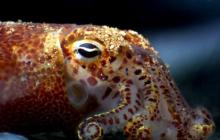

Scientists have found that a small Hawaiian squid can hide itself by using an organ with the same genes found in its eye.
Using a process called bioluminescence, the squid can light up its underside to match the surrounding light from the sun. This disguises the squid in much the same way that it discharges black ink to cloak itself. The study was recently reported in the Proceedings of the National Academies of Science.
The squid, commonly called Hawaiian Bobtail squid, has a light organ that is totally separate from the eyes. The new finding is that this organ is light sensitive and uses some of the same genes as the squid's eye.
Todd Oakley, an evolutionary biologist at UC Santa Barbara, performed the evolutionary analysis of the genes of the squid. He confirmed that the genes in the light organ are similar or the same as those of the eye of the squid.
"This is significant because it is an example of how existing components can be used in evolution to make something completely new," said Oakley. "These components existed for use in the eye and then got recruited for use in the light organ. The light organ resembles an eye in a lot of ways. It has a lens for focusing the light. It has the shape of an eye, and now we found that it has the sensitivity of an eye as well."
Oakley explained that the analogy used is "evolutionary tinkering." "Evolution acts a lot like a tinkerer and assembles what's available to make something new," he said.
The scientists gathered the small squid in shallow water in Hawaii, after sunset, when they are active. "We scoop them up with a net," said Oakley. "Then we bring them back, and keep male and female pairs together. Then they have lots of young that we can study in the lab." The squid are located in a lab at the University of Wisconsin.
"The reason that the squid are bioluminescent is for camouflage," said Oakley. "You can imagine that if you were lying on the bottom of the ocean looking up, there is a lot of light coming from above. When the squid passes over, it would cast a shadow; it would be pretty conspicuous."
To camouflage itself, the squid matches the light behind it, using bioluminescence. It matches the surrounding light so that it does not cast a shadow.
The light is caused by bacteria that are housed in the squid. It harbors the bacteria and the bacteria themselves produce the light. The scientists confirmed that the squid can actually detect the light that it is producing, by confirming that many of the genes used in the eye are also used in the light organ.
The light comes from a chemical reaction that happens within the bacteria. The squid doesn't control the chemical reaction directly, but the squid can change its light organ to make it more or less open –– to let out more or less light, Oakley explained.
Other authors involved in this paper are Deyan Tong, Margaret J. McFall-Ngai, Natalia S. Rozas, and Nansi J. Colley, of the University of Wisconsin-Madison. Another co-author is Jane Mitchell, of the University of Toronto.
Related Links



